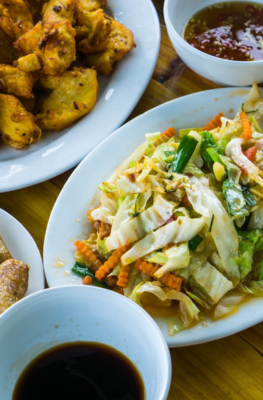Published on October 9, 2018
Taste of Southeast Asia: Dining in Viet Nam
Welcome to the Taste of ASEAN.
This is the seventh post in our blog series about the cuisines of Southeast Asia. Follow along as we explore the culinary traditions of Southeast Asia and learn about foods you can try on your summer vacations. Our hope is for visitors traveling to Asia to understand local flavors and plan to explore the authentic tastes of these places during their next holiday.
We are showing off the incredible bounty of tropical produce and agriculture of the entire ASEAN region as we talk about the cultural history behind regional dishes. Join us on this culinary adventure.
Ten amazing countries, thousands of incredible dishes!
Vietnamese Cuisine
The country of Viet Nam on the South China Sea is known for the Mekong river delta in the south and the craggy islands of Ha Long Bay in the north. The capital city of Hanoi in the north sees its counterpart in Ho Chi Minh City (formerly Saigon) as a bustling southern metropolis. In those two cities, about 15 million of Viet Nam’s 100 million residents are concentrated. As you travel from the north to the south, everything from the history to the accents to the regional dishes is prevalent and distinct. Northern flavors are balanced, central flavors are peppery, and southern flavors are vibrant with fresh herbs and strong flavors.
What is common to all Vietnamese cuisine around the country is the harmony of texture: crisp vegetables pair with papery rice wrappers, saucy dumplings pair with crunchy fried shallots, delicate meats with rough and crusty baguettes, and tendon with a firm bite gets paired with supple noodles.
Let’s explore some easily accessible favorites from Viet Nam that you can try on your summer vacations.
Bánh Mì
Bánh mi is a dish that tells the story of French colonial times on the Indochinese Peninsula. This dish is a sandwich made with European bread and Vietnamese fillings. Banh mi is sold on street corners from and it can be found on the menu at fine hotels. This food is truly the epitome of hi-lo and has become a popular Vietnamese export. It consists mainly of a crunchy (often char-grilled) baguette, liver pate, meat or egg, and crunchy vegetables such as pickled daikon white radish, shredded carrot, small chilies, and fresh coriander. Soy sauce and sometimes butter add depth of flavor.
The difference between a street-priced sandwich and a hotel sandwich is typically the filling. Though high quality fillings such as barbeque pork and pressed fish cakes are found in some locations, the typical fare sold at street food carts are made with more humble fixings. Liver pate is still used to sauce the bread but instead of grilled meats, expect processed meats called thịt nguội which usually includes a bologna-like cold cut as well as a head cheese-style cut for that extra-textured chew.
Try making one at home by following Andrea Nguyen’s banh mi recipe from the blog Viet World Kitchen and then compare it with Banh Mi 25 street food stall in Hanoi.
Cà Phê Vietnamese Coffee
If you leave Viet Nam without trying cà phê Vietnamese coffee, then you will have truly missed out on a cultural experience. Vietnamese coffee is famous for both its flavor and presentation. Served by the individual cup with tiny aluminum pour-over coffee filters called phin, Vietnamese coffee brews right in front of you. The almost sharp Robusta smell wafts up at you, daring you to wait until it’s done before taking your first savory sip. It is a uniquely single-serve, interactive, and enjoyable way to enjoy slow drip.
For the scalding hot temperatures of summer in the south, locals go for cà phê sữa đá sweet iced coffee which comes with the familiar drip set on top of a tall glass full of ice and sweetened condensed milk. Stirring up this treat and sipping the pungent, sweet nectar is a delight you will never forget. This coffee is best enjoyed as often as possible in as many locations as possible, especially if you have long days of sightseeing on your calendar. Start warm in the morning and switch to iced by the afternoon. As beans are roasted in small batches, no two coffees are quite the same.
From sandwiches to soups, coffees to desserts, Vietnamese cuisine is known for the clarity of flavor. Ingredients are fresh and combinations of flavors are straightforward. When you are traveling to Asia with your friends, see if you can describe the different ingredients in a dish using taste alone. Start with banh mi and ca phe and then get more adventurous.
Thank you for exploring the flavors of Viet Nam with us. Won’t you join us for our final explorations of the cuisines of Southeast Asia?
Watch out for more of the Taste of ASEAN blog series, as we visit each country in Southeast Asia to discover what delicious things we can try. ASEAN has ten amazing countries and thousands of incredible dishes. Come with us for this incredible food journey.






